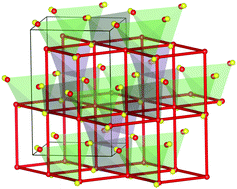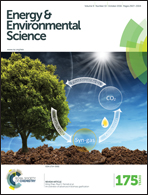Design of Li1+2xZn1−xPS4, a new lithium ion conductor†
Abstract
Recent theoretical work has uncovered that a body-centered-cubic (bcc) anion arrangement leads to high ionic conductivity in a number of fast lithium-ion conducting materials. Using this structural feature as a screening criterion, we find that the I![[4 with combining macron]](https://www.rsc.org/images/entities/char_0034_0304.gif) material LiZnPS4 contains such a framework and has the potential for very high ionic conductivity. In this work, we apply ab initio computational techniques to investigate in detail the ionic conductivity and defect properties of this material. We find that while the stoichiometric structure has poor ionic conductivity, engineering of its composition to introduce interstitial lithium defects is able to exploit the low migration barrier of the bcc anion framework. Our calculations predict a solid-solution regime extending to x = 0.5 in Li1+2xZn1−xPS4, and yield a new ionic conductor with exceptionally high lithium-ion conductivity, potentially exceeding 50 mS cm−1 at room temperature.
material LiZnPS4 contains such a framework and has the potential for very high ionic conductivity. In this work, we apply ab initio computational techniques to investigate in detail the ionic conductivity and defect properties of this material. We find that while the stoichiometric structure has poor ionic conductivity, engineering of its composition to introduce interstitial lithium defects is able to exploit the low migration barrier of the bcc anion framework. Our calculations predict a solid-solution regime extending to x = 0.5 in Li1+2xZn1−xPS4, and yield a new ionic conductor with exceptionally high lithium-ion conductivity, potentially exceeding 50 mS cm−1 at room temperature.



 Please wait while we load your content...
Please wait while we load your content...